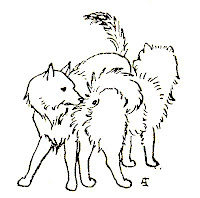In its usage today, the word “manners” lies on a spectrum between “etiquette” and “courtesy.” Etiquette encompasses practices that have to do more with locale and social standing. Such as where the fork, knife, and spoon are placed around the dinner plate. Or how a person manipulates their fork while eating. Although manners can overlap with some codes of etiquette, the word “manners” implies ways of behaving that are more fundamental to smoothing the wheels of social interaction. Such as saying “please” and “thank you.”
Even learning manners, however, does not require being sensitive to what other people are feeling (as those schoolteachers tried to remind us). Being well-mannered means that I have developed some self-restraint, civility, and forbearance in my actions. But that does not mean that I can empathize with the feelings and needs of other people amid the complexity of real-life situations -- so that I can compassionately adjust my response to the needs of the moment.
Even some non-human animals can be said to be well-mannered based on the demands of their own social groups. For example, animal behaviorists (such as the 20th-century pioneer Konrad Lorenz), have studied how dogs have evolved instinctive rituals for greeting each other. And dogs have even developed such abilities as recognizing that a human's smile showing teeth is a sign of friendliness, whereas instinct usually interprets the baring of teeth as meaning aggression. However, such an extension of knowledge beyond one's own species is uncommon. For non-human social animals, “manners” are in most cases confined to their own species.
In contrast, as the Christian eco-theologian Thomas Berry has pointed, we humans are unique in our ability to feel compassion for all other species. Although instances have been observed in which some mammals have shown distress when an animal of another species was in anguish, to the best of our knowledge, only we humans can try to identify with what all other species experience. And behind that possibility, in addition to our conceptual powers, lies the remarkable ability of humans to empathize with what another creature might be feeling.
There is a classic story out of the ancient Chinese faith-tradition of Taoism. The wise teacher Chuang Tzu and a companion, walking together, pause on a footbridge to watch the fish swimming in the water below. After a bit, Chuang Tzu says “How happy those fish are!” The second man replies, “You are not a fish. So you cannot know what a fish feels.” But Chuang Tzu cleverly responds by saying, “If that were the case -- and you not being me -- then how can you know what I do and do not know about fish?”
~ ~ ~
What do you think prevents us human beings from better cultivating our ability to empathize?
(The story “The Joy of Fishes,” in poetic stanzas,
can be found in The Way of Chuang Tzu by Thomas Merton, © 1965. pp. 97-98.)
can be found in The Way of Chuang Tzu by Thomas Merton, © 1965. pp. 97-98.)
(The pictures are from Konrad Lorenz's books Man Meets Dog and
King Solomon's Ring, and are used under Fair Use.)
King Solomon's Ring, and are used under Fair Use.)


1 comment:
Fear. Anger. Those are the two things that I think are the biggest obstacles to being empathetic.
Post a Comment